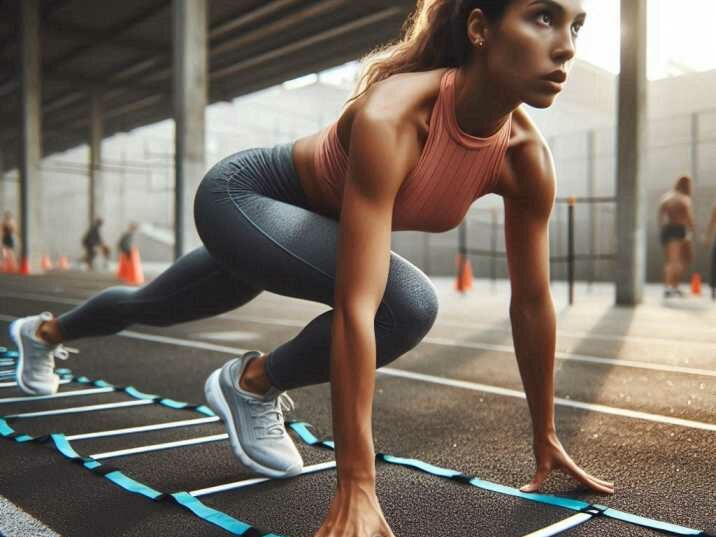Introduction:
Table of Contents
Athleticism is the cornerstone of success in sports, with agility being a defining factor in achieving peak performance. Agility ladder drills offer a dynamic and effective way to develop agility, speed, and coordination, essential skills for athletes across various disciplines. In this comprehensive guide, we’ll delve into 10 indispensable agility ladder drills, providing detailed instructions and insights to help you maximize your athletic potential.

1. Introduction to Agility Ladder Drills:
Enhancing Athletic Performance
Agility ladder drills serve as a versatile training tool, challenging athletes to navigate through a series of rungs laid out on the ground. These drills require precise footwork and quick movements, targeting key aspects of athleticism such as agility, balance, and coordination. Whether you’re a soccer player, basketball player, or track athlete, agility ladder drills can significantly improve your performance on the field or court.
Benefits of Agility Ladder Drills: Unlocking Athletic Excellence
Agility ladder drills offer a myriad of benefits for athletes striving to excel in their respective sports:
Enhanced Agility:
By performing intricate footwork patterns, athletes can improve their ability to change direction rapidly, a critical skill in sports. This agility translates directly to the field or court, allowing athletes to outmaneuver opponents with ease.
Improved Speed:
Agility ladder drills are designed to challenge athletes to move quickly and efficiently, enhancing their speed and acceleration. This increased speed not only enables athletes to reach their maximum velocity more rapidly but also aids in chasing down opponents or breaking away from defenders.
Refined Coordination:
The precise movements required in agility ladder drills promote better coordination and body control, essential for executing complex maneuvers. Athletes develop a heightened sense of spatial awareness, allowing them to navigate tight spaces and react swiftly to changes in their environment.
Increased Cardiovascular Endurance:
The high-intensity nature of agility ladder drills provides an effective cardiovascular workout, improving endurance and stamina over time. By elevating heart rate and engaging multiple muscle groups simultaneously, athletes enhance their overall cardiovascular fitness, enabling them to sustain peak performance for longer durations.
2. Mastering Agility: 10 Essential Agility Ladder Drills
Two-Feet In Drill: Precision and Speed
Begin at one end of the ladder and step both feet into each square in rapid succession, maintaining a consistent rhythm. Focus on minimizing ground contact time to maximize speed and agility.
Benefits: This drill targets foot speed, agility, and coordination, demanding precise movements and quick transitions between steps. Athletes learn to synchronize their movements to optimize efficiency and speed.
Lateral Shuffle Drill: Sideways Mobility and Quickness
Shuffle laterally through the ladder, placing one foot in each square before quickly bringing the other foot to meet it. Emphasize maintaining a low stance and generating power from the hips to enhance lateral explosiveness.
Benefits: The lateral shuffle drill enhances lateral movement capabilities and agility, crucial for evading opponents and maintaining defensive positioning in sports such as basketball and soccer. Athletes develop quick reflexes and improve their ability to react swiftly to changes in direction.
In-Out Drill: Agility and Change of Direction
Step one foot into the ladder, followed by the other foot, then step the first foot out, and continue alternating between in and out movements. Focus on maintaining balance and stability while executing rapid changes of direction.
Benefits: The in-out drill develops agility, quick change of direction, and spatial awareness, essential for navigating crowded or congested areas on the field or court. Athletes enhance their ability to decelerate and accelerate efficiently, gaining a competitive edge in stop-and-go situations.
Forward-Backward Drill: Versatility and Fluidity
Step forward into each ladder square with both feet, then step backward, maintaining a steady pace and rhythm. Concentrate on maintaining an upright posture and driving through the balls of the feet to maximize power and efficiency.
Benefits: The forward-backward drill improves forward and backward movement mechanics, enhancing agility and acceleration in both directions. Athletes develop fluidity in their movements, allowing for seamless transitions between forward sprints and backward retreats.
Ickey Shuffle Drill: Agility and Footwork Precision
Move laterally through the ladder, crossing one foot in front of the other in a crisscross pattern while maintaining quick, precise steps. Focus on maintaining a stable base and rhythm throughout the drill.
Benefits: The Ickey shuffle drill enhances agility, coordination, and balance, requiring athletes to execute precise footwork while maintaining forward momentum. Athletes develop the ability to change direction rapidly and explosively, simulating the quick cuts and changes of direction required in sports such as football and tennis.
One-Foot In Drill: Balance and Stability
Step one foot into each ladder square while keeping the other foot elevated, alternating between feet as you progress through the ladder. Focus on maintaining a stable base and controlling movements with the supporting leg.
Benefits: The one-foot in drill improves balance, proprioception, and single-leg stability, essential for maintaining stability and control in dynamic situations. Athletes develop a heightened sense of body awareness and improve their ability to stabilize on uneven surfaces.
High-Knee Drill: Explosiveness and Power
Drive your knees up high as you step through each square of the ladder, maintaining a rapid pace and focusing on explosiveness. Emphasize driving through the balls of the feet and maintaining an upright posture.
Benefits: The high-knee drill increases leg power, improves running form, and boosts cardiovascular fitness, making it an excellent conditioning exercise for athletes in all sports. Athletes develop explosive power in the lower body, allowing for quick acceleration and powerful strides.
Single-Leg Hop Drill: Strength and Control
Hop on one foot through the ladder, landing lightly in each square before hopping to the next, emphasizing control and balance. Focus on maintaining a soft landing and absorbing shock through the hips and knees.
Benefits: The single-leg hop drill strengthens ankles and calves, enhances proprioception, and refines single-leg stability, reducing the risk of lower extremity injuries. Athletes develop the ability to generate power and absorb force efficiently, improving overall athletic performance.
180-Degree Drill: Agility and Adaptability
Hop and rotate 180 degrees between each ladder square, facing the opposite direction with each turn, emphasizing agility and quick changes of direction. Focus on maintaining balance and control while executing rapid rotations.
Benefits: The 180-degree drill enhances agility, spatial awareness, and rotational movement capabilities, allowing athletes to navigate tight spaces and evade defenders with ease. Athletes develop the ability to change direction quickly and efficiently, maintaining momentum and control in dynamic situations.
Zigzag Drill: Dynamic Movement and Agility
Move diagonally through the ladder, alternating between forward and lateral steps to create a zigzag pattern, challenging multi-directional agility. Focus on maintaining a low center of gravity and driving off the balls of the feet.
Benefits: The zigzag drill improves agility, body control, and the ability to maneuver through varying directions and angles, simulating the unpredictable movements encountered in sports. Athletes develop the ability to change direction rapidly and explosively, maintaining balance and control in dynamic environments.

Summary of Essential Agility Ladder Drills
| Drill Name | Description | Benefits |
|---|---|---|
| Two-Feet In Drill | Rapidly step both feet into each ladder square | Improves foot speed, agility, and coordination |
| Lateral Shuffle Drill | Shuffle laterally through ladder, alternating feet | Enhances lateral movement and agility |
| In-Out Drill | Step one foot in and out of ladder squares | Develops agility, change of direction, spatial awareness |
| Forward-Backward Drill | Step forward and backward through ladder | Improves forward/backward movement mechanics |
| Ickey Shuffle Drill | Crisscross feet while moving laterally | Enhances agility, coordination, and balance |
| One-Foot In Drill | Step one foot into ladder squares | Improves balance, stability, and proprioception |
| High-Knee Drill | Drive knees high while moving through squares | Increases leg power, improves running form |
| Single-Leg Hop Drill | Hop on one foot through ladder squares | Strengthens ankles, enhances stability |
| 180-Degree Drill | Rotate 180 degrees between ladder squares | Enhances agility, spatial awareness |
| Zigzag Drill | Move diagonally through ladder in zigzag pattern | Improves multi-directional agility |
This table provides a concise summary of each agility ladder drill, including its description and associated benefits. By referring to this table, athletes can easily identify drills that target specific areas of athleticism and tailor their training regimen accordingly.
Conclusion:
Agility ladder drills are an effective way for athletes to enhance their agility, speed, and coordination, giving them a competitive edge in their respective sports. By incorporating these 10 essential drills into their training routine, athletes can take their performance to new heights and achieve their athletic goals.
FAQs (Frequently Asked Questions):
Q1. How often should I incorporate agility ladder drills into my training routine?
A: Aim to perform agility ladder drills 2-3 times per week to see noticeable improvements in agility and speed.
Q2. Can agility ladder drills help prevent injuries?
A: Yes, agility ladder drills can improve proprioception and body awareness, reducing the risk of common sports-related injuries.
Q3. Do I need special equipment to perform agility ladder drills?
A: No, an agility ladder is the only equipment required, and it can be easily purchased online or at sporting goods stores.
Q4. Are agility ladder drills suitable for athletes of all ages?
A: Yes, agility ladder drills can be modified to suit athletes of different ages and skill levels, making them accessible to everyone.
Q5. How long does it take to see results from agility ladder training?
A: With consistent practice, athletes can begin to see improvements in agility, speed, and coordination within a few weeks of incorporating agility ladder drills into their routine.


